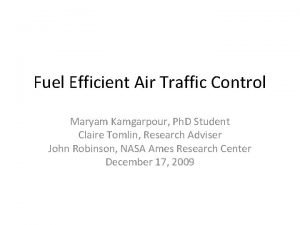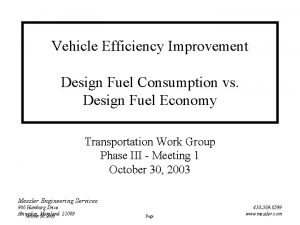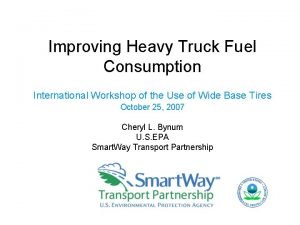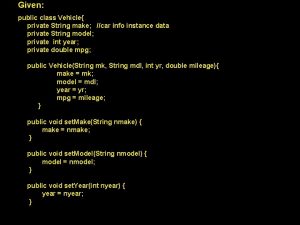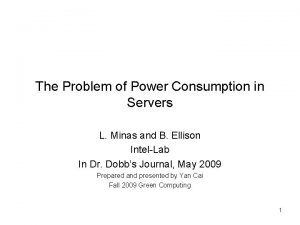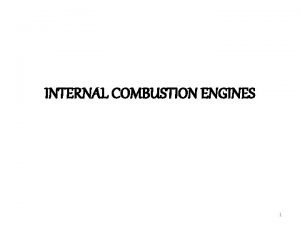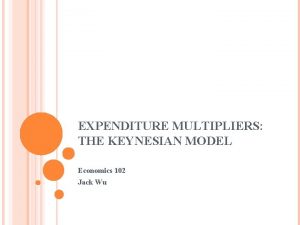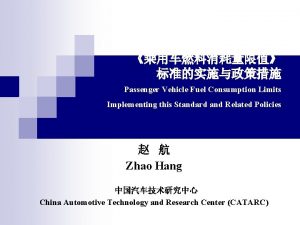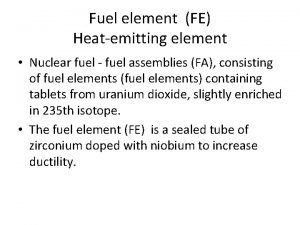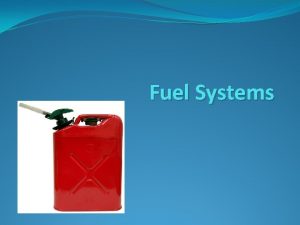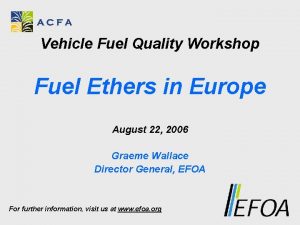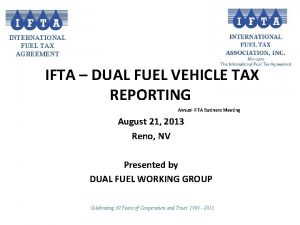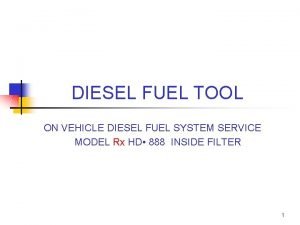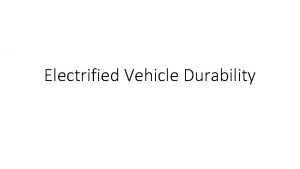Vehicle Efficiency Improvement Design Fuel Consumption vs Design


















- Slides: 18

Vehicle Efficiency Improvement Design Fuel Consumption vs. Design Fuel Economy Transportation Work Group Phase III - Meeting 1 October 30, 2003 Meszler Engineering Services 906 Hamburg Drive Abingdon, Maryland 21009 October 30, 2003 Page 410 -569 -0599 www. meszler. com

Sound Design is Essential to Success • Theory -- promote GHG reduction through penalty/reward. • Previous fee/reward structures based on EPA fuel economy (FE). • Although GHG goes down as FE goes up (and vice versa), changes are not proportional. • GHG changes are proportional to fuel consumption (FC) changes. October 30, 2003 Page 2 2

Design (EPA) FE vs. Design (EPA) FC • Basic Relationships: – FE = miles per gallon (mpg) as published by EPA. – FC = gallons per mile (as derived from EPA FE). – FC = 1 / FE ----- and ----- FE = 1 / FC • If one is just a restatement of the other, does it really make any difference? – It absolutely does, as shown in the following slides. October 30, 2003 Page 3 3

Discussion Clarification (a) • Throughout this discussion fuel consumption means the design fuel consumption rate equivalent to the design fuel economy values published by EPA. • FC is not intended to capture differences in annual gasoline use due to different mileage accumulation rates. October 30, 2003 Page 4 4

Discussion Clarification (b) • Vehicles may accumulate mileage at different rates, but lifetime mileage will be similar. – A 50, 000 miles/year vehicle will be gone in 2 -3 years. – A 10, 000 miles/year vehicle will be around for 12 -15 years. – The total emissions load will be similar for both (ignoring other differences like maintenance habits). – High VMT drivers will be subject to fee/rebate more often as their vehicles “consume” their lives quicker. October 30, 2003 Page 5 5

Fuel Economy or Fuel Consumption mpg or gallons/mile -- What Difference Does it Make? 10 mpg to 20 mpg: FE increases by 10 mpg - FC decreases by 5 gals/100 miles. 20 mpg to 40 mpg: FE increases by 20 mpg - FC decreases by 2. 5 gals/100 miles. 40 mpg to 80 mpg: FE increases by 40 mpg - FC decreases by 1. 25 gals/100 miles. October 30, 2003 Page 6 6

Fuel Economy or Fuel Consumption Practical Difference Under FE-based design 13 mpg vehicle pays $3000 for consuming 3. 1 gal/100 mi more fuel than a 22 mpg vehicle. 37 mpg vehicle gets $3000 for consuming 1. 8 gal/100 mi less. Reduction is “worth more” than increase. From an “equal value” perspective, a 72 mpg vehicle would consume 3. 1 gal/100 mi less. October 30, 2003 Page 7 7

Additional Detail and Expanded Explanations of Technical Issues October 30, 2003 Page 8 8

Fuel Economy or Fuel Consumption • Question: What difference does it make, aren’t they the same thing? • Answer: No. They are related, but not in a linear fashion. Thus, a change in one does not induce an equal change in the other. Direct GHG insights can only be gained through fuel consumption. • Why: Because CO 2 emissions are directly and linearly related to fuel consumption. October 30, 2003 Page 9 9

FE vs. FC - Example Illustration (a) • Take 2 vehicles with fuel economy (FE) values of 15 and 45 mpg. This is often interpreted as implying an “expected” average mpg of 30. • Balance is presumed because the 15 mpg vehicle gets 50% worse than expected FE, while the 45 mpg vehicle gets 50% better than expected FE. • However, actual average FE is not 30 mpg, and average CO 2 is not that of a 30 mpg vehicle. October 30, 2003 Page 10 10

FE vs. FC - Example Illustration (b) • 30 mpg is the average FE only in a restricted case where fuel is rationed equally across vehicles. • E. g. , each vehicle is allotted 5 K gallons of fuel over its lifetime. At 15 mpg, vehicle 1 can travel 75 K miles, while at 45 mpg, vehicle 2 goes 225 K miles. Together, 300 K miles are traveled on 10 K gallons of fuel for a net FE of 30 mpg. • However, in reality each vehicle has a similar lifetime mileage and uses fuel accordingly. October 30, 2003 Page 11 11

FE vs. FC - Example Illustration (c) • E. g. , each vehicle travels 150 K miles over its lifetime. At 15 mpg, vehicle 1 uses 10 K gallons, while at 45 mpg, vehicle 2 uses 3. 3 K gallons. Like before, 300 K miles are traveled, but on 13. 3 K gallons of fuel (instead of 10 K), for a net FE of 22. 5 mpg. • Since fuel consumption (FC) increases with the inverse of FE (1/FE), average FC is biased toward lower FE. October 30, 2003 Page 12 12

FE vs. FC - Example Illustration (d) • At 22. 5 mpg, average fuel consumption is 6666. 7 gallons per lifetime (or 0. 0444 gal/mi). • At 15 mpg, vehicle 1 uses 50% more fuel (0. 0666 gal/mi) and produces 50% more CO 2. • At 45 mpg, vehicle 2 uses 50% less fuel (0. 0222 gal/mi) and produces 50% less CO 2. • Even though vehicle 1’s FE is “only” 33% worse than average while vehicle 2’s FE is 100% better! October 30, 2003 Page 13 13

FE vs. FC - Example Illustration (e) • Conversely, if we run the calculations using an average FE of 30 mpg, vehicles 1 and 2 are 50% worse and 50% better respectively in terms of FE, but their CO 2 emissions do not vary equally. • At 30 mpg, average fuel consumption is 0. 0333 gal/mi), so the 15 mpg vehicle produces 100% more CO 2 while the 45 mpg vehicle produces “only” 33 percent less. October 30, 2003 Page 14 14

FE vs. FC - Example Illustration (f) • Conclusion: If the penalty/reward structure of an efficiency program is intended to accurately reflect GHG performance, it must be based on FC. • Of course, fees can be assigned to specific FE values, but all underlying calculations must be performed in FC “space. ” October 30, 2003 Page 15 15

2003 FE by Class (National Data) Data include automatic transmission vehicles only, manual transmission versions with 3 -5 percent lower fuel consumption are available for many models. October 30, 2003 Page 16 16

2003 FC by Class (National Data) Data include automatic transmission vehicles only, manual transmission versions with 3 -5 percent lower fuel consumption are available for many models. October 30, 2003 Page 17 17

2003 CO 2 by Class (National Data) Data include automatic transmission vehicles only, manual transmission versions with 3 -5 percent lower fuel consumption are available for many models. October 30, 2003 Page 18 18
 Fuel consumption rate
Fuel consumption rate Fuel consumption
Fuel consumption Fuel consumption
Fuel consumption Fuel monitoring system for trucks
Fuel monitoring system for trucks Opportunity cost formula
Opportunity cost formula Allocative efficiency vs productive efficiency
Allocative efficiency vs productive efficiency Allocative efficiency vs productive efficiency
Allocative efficiency vs productive efficiency Private string java
Private string java World tea consumption
World tea consumption Server power consumption
Server power consumption Tea market in canada
Tea market in canada Drinking fountain
Drinking fountain Complementation
Complementation Government spending multiplier formula
Government spending multiplier formula Mean effective pressure in ic engine
Mean effective pressure in ic engine Keynesian consumption function
Keynesian consumption function Consumption function formula
Consumption function formula Definition of food preparation
Definition of food preparation Consumption expenditures formula
Consumption expenditures formula
